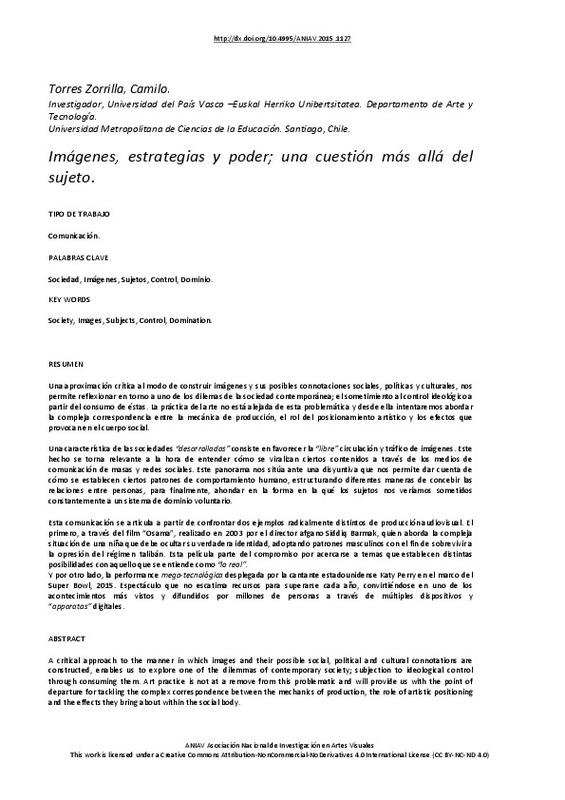JavaScript is disabled for your browser. Some features of this site may not work without it.
Buscar en RiuNet
Listar
Mi cuenta
Estadísticas
Ayuda RiuNet
Admin. UPV
Imágenes, estrategias y poder; una cuestión más allá del sujeto
Mostrar el registro sencillo del ítem
Ficheros en el ítem
| dc.contributor.author | Torres Zorrilla, Camilo
|
es_ES |
| dc.date.accessioned | 2017-10-16T10:38:35Z | |
| dc.date.available | 2017-10-16T10:38:35Z | |
| dc.date.issued | 2015-11-26 | |
| dc.identifier.isbn | 9788490483411 | |
| dc.identifier.uri | http://hdl.handle.net/10251/89188 | |
| dc.description.abstract | [EN] A critical approach to the manner in which images and their possible social, political and cultural connotations are constructed, enables us to explore one of the dilemmas of contemporary society; subjection to ideological control through consuming them. Art practice is not at a remove from this problematic and will provide us with the point of departure for tackling the complex correspondence between the mechanics of production, the role of artistic positioning and the effects they bring about within the social body. It is a characteristic of “developed” societies to encourage the “free” circulation and traffic of images. This circumstance becomes relevant to understanding how some content is viralized through the mass communications media and social networks. This panorama brings us to a juncture that makes it possible to discern how certain patterns of human behaviour are established, structuring different ways of conceiving relations between people, and thereby to uncover the way in which the subject is constantly subordinated to a system of voluntary domination. This communication is articulated through a comparison between two radically different examples of audio--‐visual production. The first comes in the shape of the film “Osama” made in 2003 by Afghan director Siddiq Barmak, who approaches the complex situation of a girl who must conceal her true identity, adopting male patterns in order to survive the oppression of the Taliban regime. This film is driven by a commitment to hone in on themes that establish different possibilities via what is understood as “the real”. Then there is the Mega--‐Techno spectacle unleashed in US singer Katy Perry’s performance at the Super Bowl Halftime Show, 2015. A show that spares no expense in order to surpass itself year after year, becoming one of the events to be most seen and disseminated by millions of people through a multiplicity of digital devices and ‘app’aratuses. | es_ES |
| dc.description.abstract | [ES] Una aproximación crítica al modo de construir imágenes y sus posibles connotaciones sociales, políticas y culturales, nos permite reflexionar en torno a uno de los dilemas de la sociedad contemporánea; el sometimiento al control ideológico a partir del consumo de éstas. La práctica del arte no está alejada de esta problemática y desde ella intentaremos abordar la compleja correspondencia entre la mecánica de producción, el rol del posicionamiento artístico y los efectos que provocan en el cuerpo social. Una característica de las sociedades “desarrolladas” consiste en favorecer la “libre” circulación y tráfico de imágenes. Este hecho se torna relevante a la hora de entender cómo se viralizan ciertos contenidos a través de los medios de comunicación de masas y redes sociales. Este panorama nos sitúa ante una disyuntiva que nos permite dar cuenta de cómo se establecen ciertos patrones de comportamiento humano, estructurando diferentes maneras de concebir las relaciones entre personas, para finalmente, ahondar en la forma en la qué los sujetos nos veríamos sometidos constantemente a un sistema de dominio voluntario. Esta comunicación se articula a partir de confrontar dos ejemplos radicalmente distintos de producción audiovisual. El primero, a través del film “Osama”, realizado en 2003 por el director afgano Siddiq Barmak, quien aborda la compleja situación de una niña que debe ocultar su verdadera identidad, adoptando patrones masculinos con el fin de sobrevivir a la opresión del régimen talibán. Esta película parte del compromiso por acercarse a temas que establecen distintas posibilidades con aquello que se entiende como “lo real”. Y por otro lado, la performance mega-tecnológica desplegada por la cantante estadounidense Katy Perry en el marco del Super Bowl, 2015. Espectáculo que no escatima recursos para superarse cada año, convirtiéndose en uno de los acontecimientos más vistos y difundidos por millones de personas a través de múltiples dispositivos y “apparatos” digitales. | es_ES |
| dc.format.extent | 7 | es_ES |
| dc.language | Español | es_ES |
| dc.publisher | Editorial Universitat Politècnica de València | es_ES |
| dc.relation.ispartof | II CONGRESO INTERNACIONAL DE INVESTIGACIÓN DE ARTES VISUALES | es_ES |
| dc.rights | Reconocimiento - No comercial - Sin obra derivada (by-nc-nd) | es_ES |
| dc.subject | Arte | es_ES |
| dc.subject | Producción artística | es_ES |
| dc.subject | Estética | es_ES |
| dc.subject | Teoría del arte | es_ES |
| dc.subject | Gestion cultural | es_ES |
| dc.subject | Educación artística | es_ES |
| dc.subject | Investigación artística | es_ES |
| dc.title | Imágenes, estrategias y poder; una cuestión más allá del sujeto | es_ES |
| dc.type | Capítulo de libro | es_ES |
| dc.type | Comunicación en congreso | es_ES |
| dc.identifier.doi | 10.4995/ANIAV2015.1127 | |
| dc.rights.accessRights | Abierto | es_ES |
| dc.description.bibliographicCitation | Torres Zorrilla, C. (2015). Imágenes, estrategias y poder; una cuestión más allá del sujeto. En II CONGRESO INTERNACIONAL DE INVESTIGACIÓN DE ARTES VISUALES. Editorial Universitat Politècnica de València. 678-684. https://doi.org/10.4995/ANIAV2015.1127 | es_ES |
| dc.description.accrualMethod | OCS | es_ES |
| dc.relation.conferencename | II Congreso Internacional de Investigación en Artes Visuales. |< real | virtual >| ANIAV2015 | es_ES |
| dc.relation.conferencedate | July 09-10,2015 | es_ES |
| dc.relation.conferenceplace | Valencia, Spain | es_ES |
| dc.relation.publisherversion | http://ocs.editorial.upv.es/index.php/ANIAV/ANIAV2015/paper/view/1127 | es_ES |
| dc.description.upvformatpinicio | 678 | es_ES |
| dc.description.upvformatpfin | 684 | es_ES |
| dc.type.version | info:eu-repo/semantics/publishedVersion | es_ES |
| dc.relation.pasarela | OCS\1127 | es_ES |








